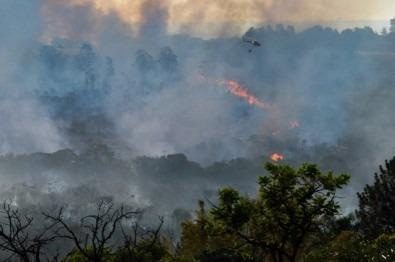Brazilian researchers illustrate how wildfires and forest burning for agriculture purposes impacts rain cloud formation in the Amazon. Details of the research have been published in the journal Communications Earth & Environment.
 Particles released into the atmosphere by fire modify the water droplet freezing process and can affect precipitation, according to a paper in Communications Earth & Environment. Image Credit: archive/Agência Brasil
Particles released into the atmosphere by fire modify the water droplet freezing process and can affect precipitation, according to a paper in Communications Earth & Environment. Image Credit: archive/Agência Brasil
According to the researchers, aerosols (minute solid particles and liquid droplets discharged into the air by fire) hamper the freezing of cloud droplets when the air is humidified and can stimulate freezing when the air is dry. This changes the regular functioning of clouds and their characteristic height, impacting precipitation and the amount of sunlight hitting the ground.
To arrive at this deduction, the researchers used a large dataset gathered over a 15-year period, from 2000 to 2014, involving measurements of atmospheric aerosols from fires made by NASA’s Aerosol Robotic Network (AERONET), satellite imagery from the United States National Oceanic and Atmospheric Administration (NOAA), and reanalysis data from the European Center for Medium-Range Weather Forecasts (ECMWF).
Reanalysis data offers the most comprehensive picture presently possible of past weather and climate, combining observations and past forecasts rerun with contemporary forecasting models, according to ECMWF.
The images and reanalysis data from the satellite encompassed the complete Amazon region. The aerosol data covered five areas in southern Amazonia: Alta Floresta and Cuiabá in Mato Grosso state; Rio Branco in Acre state; and Ji-Paraná and Ouro Preto do Oeste in Rondônia state.
The purpose of the exploration was to carry out an observational study of the temperature at which droplets freeze in convective clouds, which develop vertically and can reach heights surpassing 10 km to identify the main drivers of the occurrence. The presence of ice in clouds is essential since it impacts the formation of rain and the average time clouds stay in the air.
The longer clouds last on average, the more solar radiation is reflected back into space, contributing to the cooling of the planet.
Alexandre Correia, Study First Author and Professor, Department of Applied Physics, Institute of Physics (IF-USP), University of São Paulo
The research received support from FAPESP. The co-authors were Maria A. F. Silva Dias (Institute of Astronomy, Geophysics and Atmospheric Sciences, IAG-USP), Elisa Sena (Federal University of São Paulo), and Ilan Koren (Weizmann Institute of Science, Israel).
The findings reveal that freezing, which occurs at around -10°C instead of 0°C, relies essentially on a combination of three aspects: solar radiation, atmospheric humidification, and aerosols.
During the rainy season in southern Amazonia (approximately December-April), the air is very clear, and the source of the particles in the aerosols is natural. They result from the condensation of gases produced by the forest as well as from wind abrasion of soil and vegetation and usually contain microorganisms, pollen, and sea salt, among other types of particles.
In the burning season, which happens yearly in August-October, massive fires produce a large quantity of smoke, which spreads all over the region and is carried by the wind to other regions as well. Alexandre Correia, Study First Author and Professor explains, "They produce much worse pollution than urban activities in the city of São Paulo, for example."
The research added to the knowledge regarding the behavior of clouds in the Amazon and can be enhanced by additional exploration.
The influence of clouds on the climate is very important. This is the most complex topic in climate models that set out to forecast what will happen with regard to this theme in the future, so any improvement in knowledge of how clouds function is a major contribution to the advancement of climate science.
Alexandre Correia, Study First Author and Professor, Department of Applied Physics, Institute of Physics (IF-USP), University of São Paulo
Journal Reference:
Correia, A.L., et al. (2021) Preconditioning, aerosols, and radiation control the temperature of glaciation in Amazonian clouds. Communications Earth & Environment. doi.org/10.1038/s43247-021-00250-3.